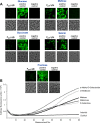PafR, a novel transcription regulator, is important for pathogenesis in uropathogenic Escherichia coli
- PMID: 25069986
- PMCID: PMC4187875
- DOI: 10.1128/IAI.00086-14
PafR, a novel transcription regulator, is important for pathogenesis in uropathogenic Escherichia coli
Abstract
The metV genomic island in the chromosome of uropathogenic Escherichia coli (UPEC) encodes a putative transcription factor and a sugar permease of the phosphotransferase system (PTS), which are predicted to compose a Bgl-like sensory system. The presence of these two genes, hereby termed pafR and pafP, respectively, has been previously shown to correlate with isolates causing clinical syndromes. We show here that deletion of both genes impairs the ability of the resulting mutant to infect the CBA/J mouse model of ascending urinary tract infection compared to that of the parent strain, CFT073. Expressing the two genes in trans in the two-gene knockout mutant complemented full virulence. Deletion of either gene individually generated the same phenotype as the double knockout, indicating that both pafR and pafP are important to pathogenesis. We screened numerous environmental conditions but failed to detect expression from the promoter that precedes the paf genes in vitro, suggesting that they are in vivo induced (ivi). Although PafR is shown here to be capable of functioning as a transcriptional antiterminator, its targets in the UPEC genome are not known. Using microarray analysis, we have shown that expression of PafR from a heterologous promoter in CFT073 affects expression of genes related to bacterial virulence, biofilm formation, and metabolism. Expression of PafR also inhibits biofilm formation and motility. Taken together, our results suggest that the paf genes are implicated in pathogenesis and that PafR controls virulence genes, in particular biofilm formation genes.
Copyright © 2014, American Society for Microbiology. All Rights Reserved.
Figures





References
-
- Mobley H, Warren J. 1996. Urinary tract infections: molecular pathogenesis and clinical management. ASM Press, Washington, DC
Publication types
MeSH terms
Substances
LinkOut - more resources
Full Text Sources
Other Literature Sources
Molecular Biology Databases

